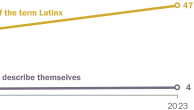Latinos with darker skin color report more discrimination experiences than Latinos with lighter skin color
Pew Research Center conducted this study to understand the role of skin color in the life experiences of Latino adults. It also measures attitudes of Latinos about race and race relations and their personal experiences with discrimination. In addition, the study explores four different ways to measure racial identity, including an assessment of skin color.
For this analysis we surveyed 3,375 U.S. Hispanic adults in March 2021. This includes 1,900 Hispanic adults on Pew Research Center’s American Trends Panel (ATP) and 1,475 Hispanic adults on Ipsos’ KnowledgePanel. Respondents on both panels are recruited through national, random sampling of residential addresses. Recruiting panelists by phone or mail ensures that nearly all U.S. adults have a chance of selection. This gives us confidence that any sample can represent the whole population (see our Methods 101 explainer on random sampling), or in this case the whole U.S. Hispanic population.
To further ensure the survey reflects a balanced cross-section of the nation’s Hispanic adults, the data is weighted to match the U.S. Hispanic adult population by age, gender, education, nativity, Hispanic origin group and other categories. Read more about the ATP’s methodology. Here are the questions used for our survey of Hispanic adults, along with responses, and its methodology.
The terms Hispanic and Latino are used interchangeably in this report.
Skin color is self-assessed based on a 10-step scale, ranging from lightest (1) to darkest (10). Latinos with lighter skin color or Latinos with lighter skin selected 1-4 on the scale while Latinos with darker skin color or Latinos with darker skin selected 5-10.
U.S. born refers to persons born in the United States and those born in other countries to parents at least one of whom was a U.S. citizen.
Foreign born refers to persons born outside of the United States to parents neither of whom was a U.S. citizen. The terms foreign born and immigrant are used interchangeably in this report. For the purposes of this report, foreign born also refers to those born in Puerto Rico. Although individuals born in Puerto Rico are U.S. citizens by birth, they are included among the foreign born because they are born into a Spanish-dominant culture and because on many points their attitudes, views and beliefs are much closer to Hispanics born abroad than to Hispanics born in the 50 states or the District of Columbia, even those who identify themselves as being of Puerto Rican origin.
First generation refers to foreign-born people. The terms “foreign born,” “first generation” and “immigrant” are used interchangeably in this report.
Second generation refers to people born in the 50 states or the District of Columbia, with at least one first-generation, or immigrant, parent.
Third or higher generation refers to people born in the 50 states or the District of Columbia, with both parents born in the 50 states or the District of Columbia.
Language dominance is a composite measure based on self-described assessments of speaking and reading abilities. Spanish-dominant people are more proficient in Spanish than in English (i.e., they speak and read Spanish “very well” or “pretty well” but rate their English-speaking and reading ability lower). Bilingual refers to people who are proficient in both English and Spanish. English-dominant people are more proficient in English than in Spanish.
The perceived impact of skin color in the lives of U.S. Latinos is broad. From impacting their ability to get ahead in the country to shaping their daily life experiences to dealing with discrimination, skin color is seen by Latinos as an important factor affecting their lives and life chances.
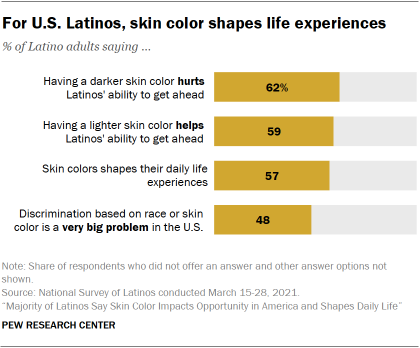
A majority (62%) of Hispanic adults say having a darker skin color hurts Hispanics’ ability to get ahead in the United States today at least a little. A similar share (59%) say having a lighter skin color helps Hispanics get ahead. And 57% say skin color shapes their daily life experiences a lot or some, with about half saying discrimination based on race or skin color is a “very big problem” in the U.S. today, according to Pew Research Center’s National Survey of Latinos, a bilingual, national survey of 3,375 Hispanic U.S. adults conducted in March 2021.
Colorism is a form of discrimination based on skin color, usually, though not always, favoring lighter skin color over darker skin color within a racial or ethnic group. While it can be tied to racism, it is not necessarily the same. (Racism is prejudice directed at members of a racial or ethnic group because of their origin.) For example, Hispanics in the U.S. may face discrimination because they are Hispanic (a form of racism), but the degree of discrimination may vary based on skin color, with those of darker shades experiencing more incidents (a form of colorism). And because of colorism’s deep roots in the histories of Latin America and the United States, discrimination based on skin color can occur among Hispanics just as much as it can be directed at Hispanics by non-Hispanics.
To measure this dimension of Latino identity in the United States, the survey asked respondents to identify the skin color that best resembled their own using a version of the Yadon-Ostfeld skin-color scale. Respondents were shown ten skin colors that ranged from fair to dark (see text box below for the images and scale used). Fully 80% of Latino adults selected a color between one and four, or lighter skin colors, while 15% selected a color between five and ten on the scale, or darker skin colors.1
Discrimination and skin color
Colorism in the Americas
Discrimination based on skin color has deep historical roots in Latin America and the Caribbean. Centuries ago, a hierarchical or caste system was established in the Americas, tying privilege, individual worth and access to opportunities to one’s skin color, race and birthplace. This was further shaped by the arrival of slaves from Africa across the region and the mixing of Indigenous, European and African populations.
Today, skin color remains an important determinant of outcomes across the region. Individuals with darker skin achieve lower levels of educational attainment or have less access to health care, for example. And those of lighter skin color experience less discrimination than those of darker skin color.
Colorism is present in the U.S. as well and has similarly impacted the lives of Hispanics, Black Americans and Asian Americans, existing alongside racial discrimination. And it is similarly linked to a number of outcomes. For example, racism may impact both Hispanics of lighter skin and darker skin color, but Hispanics with darker skin may experience more discrimination.
Overall, about half (54%) of Hispanic adults experienced at least one of the eight discrimination incidents asked about in the survey, reflecting broader and ongoing experiences with discrimination among U.S. Hispanics no matter their skin color. However, the new survey finds Hispanics with darker skin color are more likely to have experienced at least one discrimination incident than Hispanics with lighter skin color. Nearly two-thirds (64%) of Hispanics with darker skin say they personally experienced at least one of the eight discrimination incidents during the year previous to the survey, while 54% of Hispanics with lighter skin color say the same.
Among the discrimination experiences included in the survey, being treated as if they were not smart is the most reported. Some 42% of Latinos with darker skin say this happened to them, as do 34% of Latinos with lighter skin.
The next most common discrimination experiences were those directed at Hispanics by non-Hispanics and Hispanics alike, with the chances of these incidents happening linked to skin color. Some 42% of Hispanics with darker skin personally experienced discrimination or were treated unfairly by someone who is not Hispanic, while 29% of those with lighter skin say the same happened to them. And 41% of Hispanics with darker skin say they personally experienced discrimination or were treated unfairly by someone who is Hispanic, while 25% of those who have a lighter skin color say they too experienced discrimination by someone who is Hispanic.
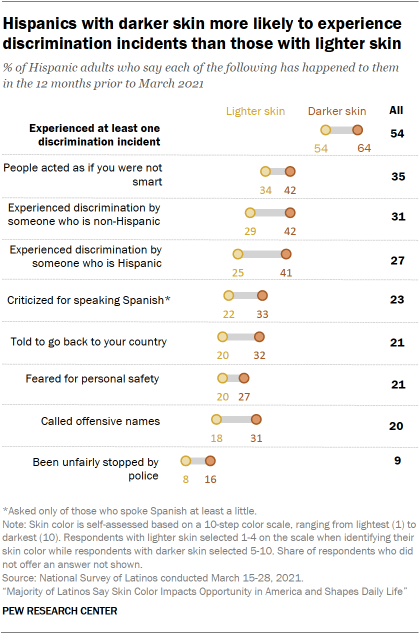
Still, no matter their skin color and despite the notable gap, Latinos are experiencing discrimination. About one-third (32%) of Latinos with darker skin say someone told them to go back to their country, for example, as did 20% 0f those with lighter skin. Some 33% of Latinos with darker skin say someone criticized them for speaking Spanish in public, as did 22% of those with lighter skin. And 27% of Latinos with darker skin say they feared for their personal safety while 20% of those with lighter skin say the same.
While Latinos’ skin color is linked to discrimination experiences, those with darker skin and lighter skin alike say skin color affects opportunity and life experiences in America. For example, majorities of both groups say skin color shapes their daily life experiences – 62% among Latinos with darker skin and 57% among Latinos with lighter skin. And both groups are just as likely to say darker skin color “hurts” Latinos’ ability to get ahead in the U.S. (63% and 64% respectively). About half (49%) of Latinos with lighter skin say discrimination based on race or skin color is a very big problem, as do 41% of those with darker skin.
Impact of race, skin color is a topic of conversation with relatives and friends for Hispanics
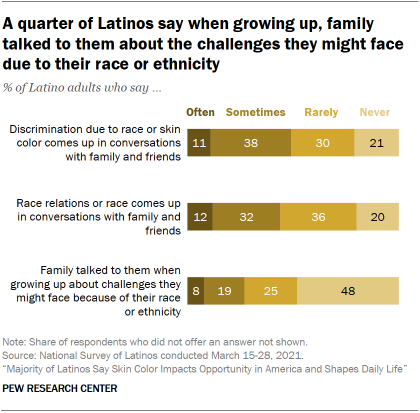
Race, skin color and the state of race relations sometimes come up in conversations Latinos have with family and friends. Roughly half (48%) say discrimination based on race or skin color is a topic in conversations at least sometimes with friends and relatives. But these conversations are not happening frequently among all Latinos. About half (51%) say these conversations with relatives and friends happen rarely (30%) or never (21%).
Conversations about racial or skin color discrimination are happening more often among Hispanics with darker skin than those with lighter skin. Six-in-ten Hispanics with darker skin color (60%) say they often or sometimes talk with family and friends about discrimination based on race or skin color, a share that falls to 46% among Hispanics with lighter skin.
And 44% say the topic of U.S. race relations often or sometimes comes up when talking with family and friends. About half (52%) of Hispanics with darker skin say this, as do 43% of Hispanics with lighter skin.
Racial identity and experiences with racism have been a part of some Latinos’ experiences growing up as well. About one-in-four Latinos (27%) say their family talked to them at least sometimes about the challenges they might face due to their race or ethnicity when they were growing up. This is more common among Latinos who indicate they have darker skin (41%) than among those who indicate they have lighter skin (25%).
Capturing skin color among U.S. Hispanics
A self-assessed measure of skin color was included in the survey as one of four measures of racial identity. The survey used a version of the Yadon-Ostfeld 10-point skin color scale, where one represents the lightest skin color and 10 the darkest. (The scale used in the survey is reproduced below.) Survey respondents were asked to select the color that most closely matches their own, even if none of them were exactly right.
Responses were distributed mostly toward lighter skin colors. Eight-in-ten Hispanics selected one of the four lightest skin colors, with the second-lightest ranking on top (28%), followed by the third (21%) and fourth lightest colors (17%). By contrast, 15% of Latino respondents selected one of the six darker skin colors, with only 3% in total selecting one of the four darkest skin colors (7-10). For this report, those who indicated their skin color is between one and four are identified as of a lighter skin color, while those who indicated their skin color is between five and 10 are identified as of a darker skin color.
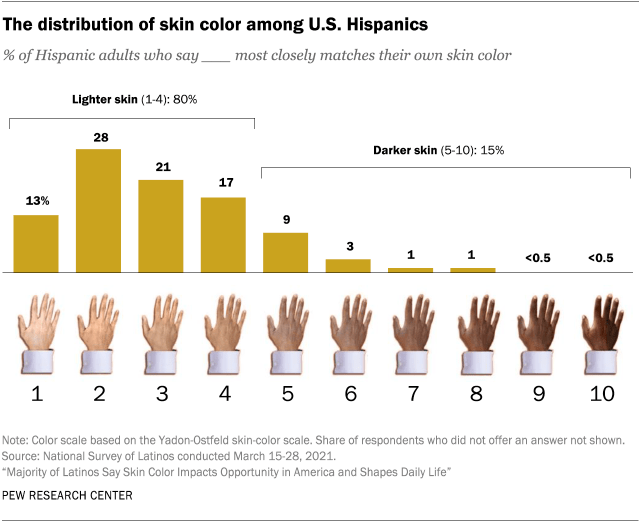
Half of Latinos say there is too little national attention on racial issues concerning Latino people
After nearly a year of national engagement over issues of race following the killing of George Floyd in May of 2020 and subsequent nationwide racial justice protests, Latinos are split over whether there is too much or too little attention paid to race and racial issues in the country today. Overall, 37% say that too little attention is paid to these issues, while 36% say there is too much attention and 25% say the amount of attention given to race and racial issues is about the right amount.
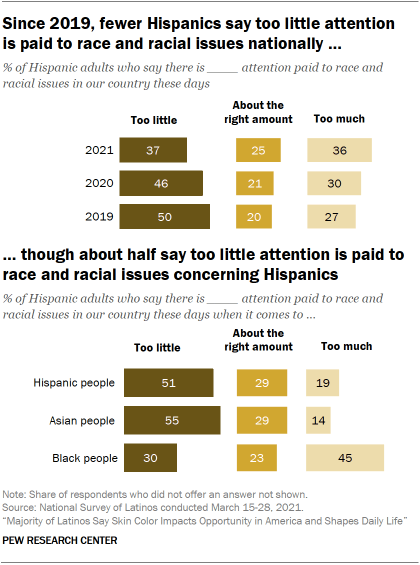
The views of Latinos on this have shifted as the share saying too little attention is paid to race relations has dipped compared with 2019 and 2020, when 50% and 46% of Latinos respectively said the same. At the same time, a growing share say there is too much attention paid to race and racial issues nationally. Some 36% say this today, up from 27% who said the same in 2019.
Even before recent events, Latinos were downbeat about race relations in the U.S. In another 2019 Pew Research Center survey, six-in-ten Latinos (60%) said race relations in the country then were generally bad and getting worse. In the same survey, more Latinos said people not seeing racism where it really does exist was a bigger problem in the country than people seeing racial discrimination where it really does not exist.
Yet, when it comes to how much attention is paid to race and racial issues concerning Hispanic people, about half of all Hispanics (51%) say too little attention is paid to them today. Among Hispanics with darker skin, 57% say too little attention is paid to racial issues concerning Hispanic people, a higher share than the 50% of those with lighter skin color who say the same.
About as many Hispanics hold this view about the level of national attention paid to race and racial issues concerning Asian people. Over half (55%) of Hispanics say too little attention is paid to race issues concerning Asian people in the country today. Meanwhile, 29% of Hispanics say the amount of national attention paid to race issues concerning Asian people is about right and 14% say too much attention is paid to these issues. (The survey was fielded just as the number of hate and violence incidents focused on Asian Americans drew wide national attention.)
At the same time, 30% of Hispanics say too little attention is paid to race and racial issues related to Black people today, while 45% say too much attention is paid to them and 23% say the right amount of attention is paid to these issues.
Hispanics often hear other Hispanics make racially insensitive comments and jokes about Hispanics and non-Hispanics alike
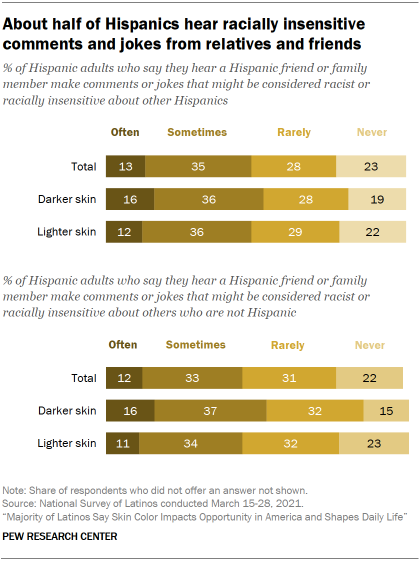
Hispanics are hearing racially insensitive comments and jokes coming from other Hispanics, according to the survey. Nearly half (48%) of Hispanic adults say they have often or sometimes heard a Hispanic friend or family member make comments or jokes about other Hispanics that might be considered racist or racially insensitive. Similar shares of Hispanics who identify with a lighter skin color (48%) or darker skin color (52%) say they have heard these types of comments or jokes from friends or family at least sometimes.
And 45% of Hispanic adults say the same about hearing a Hispanic friend or family member make racist or racially insensitive comments or jokes about others who are not Hispanic often or at least sometimes. Among Hispanics with darker skin color, 53% say this, a higher share than among Hispanics with lighter skin color (44%).
This is little changed from 2019, when a similar share of Hispanics (47%) said they heard a Hispanic friend or family member make what might be considered a racist comment about people who are not Hispanic. In the same 2019 survey, half of those who heard these comments or jokes from people close to them said they confronted a friend or family member about it.
While Hispanics say skin color affects their ability to get ahead in America, other factors are seen as important as well
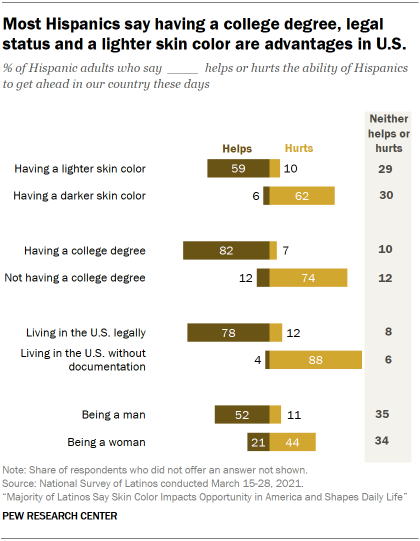
While a majority of Latinos say skin color impacts Latinos’ opportunity in the U.S. today, education and immigration status are viewed by more as having an impact on the ability to get ahead.
About eight-in-ten Hispanics (82%) say having a college degree helps the ability of Hispanics to get ahead in the U.S. these days. And 78% say the same about living in the U.S. legally. Both are higher than the 59% saying a lighter skin color helps Hispanics get ahead in America and the 62% saying a darker skin color hurts Hispanics.
When asked if gender affects Hispanics’ ability to get ahead in the U.S. today, about half (52%) of Hispanics say being a man helps, while 21% say the same about being a woman. Roughly one-in-three say that being a Hispanic man or woman is neither an advantage nor disadvantage in America today.
For Latinos, discrimination experiences and views about skin color and race are linked
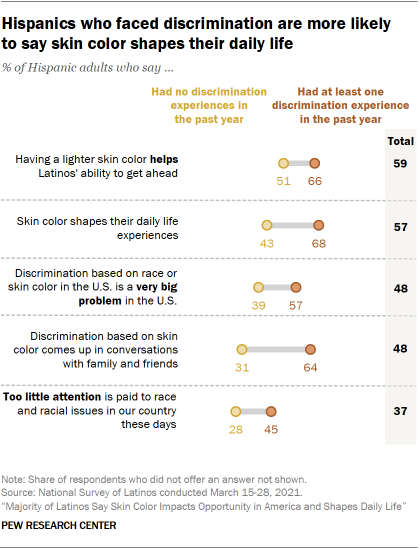
Latinos’ views on topics related to race or skin color differ by their own experiences with discrimination. Those who reported experiencing at least one of eight specific forms of discrimination asked about in the survey were more likely than those who did not report one to say having a lighter skin color helps at least a little in the ability of Hispanics to get ahead – 66% vs. 51% respectively.2
About two-thirds (68%) of Latinos who had a discrimination experience in the past year say skin color shapes their daily life experiences a lot or some, compared with 43% of those who had no discrimination experiences that say the same.
In addition, those who had at least one discrimination experience in the past year were more likely than those who did not have such experiences to say discrimination based on race or skin color is a “very big problem” in the U.S., that discrimination based on skin color comes up often or sometimes in conversations with family and friends and that too little attention is paid to race and racial issues in the U.S. these days.


